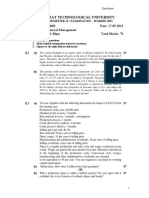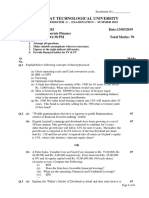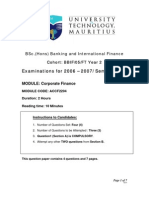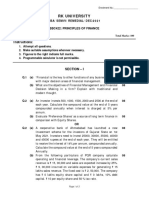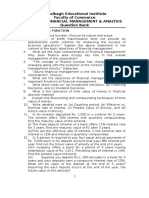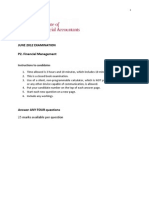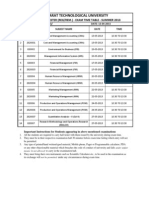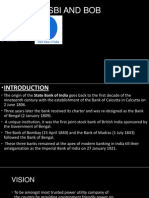Gujarat Technological University: Instructions
Gujarat Technological University: Instructions
Uploaded by
sanketchauhanCopyright:
Available Formats
Gujarat Technological University: Instructions
Gujarat Technological University: Instructions
Uploaded by
sanketchauhanOriginal Title
Copyright
Available Formats
Share this document
Did you find this document useful?
Is this content inappropriate?
Copyright:
Available Formats
Gujarat Technological University: Instructions
Gujarat Technological University: Instructions
Uploaded by
sanketchauhanCopyright:
Available Formats
Seat No.
: _____
Enrolment No.______
GUJARAT TECHNOLOGICAL UNIVERSITY
MBA. Second Semester ( Regular / Evening ) Examination May 2010
Subject code: 820003 Subject ame: Financial Management
Date: 24 / 05 / 2010 Total Marks: 70 Time : 11.00 am 01.30 pm
Instructions:
1. Attempt all questions. 2. Make suitable assumptions wherever necessary. 3. Figures to the right indicate full marks. Q.1 (a) Financial Management is that managerial activity which is concerned with 07 the planning and controlling of the firms financial resources. In view of the above statement, discuss in detail the major finance functions and the role played by the finance manager. (b) An investor has invested his savings in a company from whom dividends are 07 expected to grow @20% for 15 years and thereafter @7% forever. Find out the value of the equity share given that the current dividend per share is Re. 1 and the required rate of return of the investor is 9%. (a) Explain the concept of Working Capital and discuss in brief the major factors 07 which generally influence the working capital requirements of firms. (b) From the following information, you are required to estimate the net working 07 capital. Cost per unit (Rs.) Raw Materials 300 Direct Labour 100 Overheads (excluding Depreciation) 200 Total Cost 600 Additional Information : Selling Price Rs. 800 per unit Output 50,000 units per annum Raw Materials in Stock average 4 weeks Work-in-process : (assume 50% completion stage with full average 2 weeks material consumption) Finished Goods in Stock average 5 weeks Credit allowed to Debtors average 5 weeks Credit allowed by Creditors average 10 weeks Cash at Bank is expected to be Rs. 60,000 Assume that production is sustained at an even pace during the 52 weeks of the year. All sales are on credit basis. OR (b) G Ltd. produces a product which has a monthly demand of 4,000 units. The 07 product requires a component X which is purchased at Rs. 20. For every finished product, one unit of component is required. The ordering cost is Rs. 120 per order and the holding cost is 10% p.a. You are required to calculate : (i) Economic order quantity. (ii) If the minimum lot size to be supplied is 4,000 units, what is the extra cost, the company has to incur ?
1
Q.2
Q.3
(a) Discuss in detail the advantages and disadvantages of the various discounted 07 cash flow methods of capital budgeting. (b) The particulars about the existing capital structure of A Ltd. are given : 07 Amount Rs. Before-tax Cost (%) Equity Share Capital 8,00,000 12% Preference Share Capital 1,00,000 7% Long-term Debt 6,00,000 8% The company wants to undertake an expansion project costing Rs. 5,00,000 which can be taken from a bank at 10%. The minimum acceptable rate of return from the new project is based on the companys cost of capital. What is the minimum acceptable rate of return to the company in the case of the proposed expansion project? You may assume a 50% tax rate. OR (a) Explain the concept of cost of capital, giving its significance. Distinguish 07 between Weighted Average Cost of Capital and Weighted Marginal Cost of Capital. (b) Machine A costs Rs. 1,00,000 payable immediately. Machine B costs Rs. 07 1,20,000 half payable immediately and half payable in one years time. The cash receipts expected are as follows : Year (at the end) A B 1 20,000 -2 60,000 60,000 3 40,000 60,000 4 30,000 80,000 5 20,000 -With 7% interest which machine should be selected ?
Q.3
Q.4
(a) Describe the traditional view on the optimum capital structure. Compare and 07 contrast this view with the NOI approach and the NI approach. (b) The following is the data regarding two companies A and B belonging to the 07 same risk class : Company A Company B Number of ordinary shares 90,000 1,50,000 Market price per share (Rs.) 1.20 1.00 6% Debentures (Rs.) 60,000 --Profit before interest (Rs.) 18,000 18,000 All profits after debenture interest are distributed as dividends. Explain how under Modigliani & Miller approach, an investor holding 10% of shares in company A will be better off in switching his holding to Company B.
OR
Q.4
(a) Give in brief the major sources of long term finance. 07 (b) A firm has sales of Rs. 10,00,000 variable cost of Rs. 7,00,000 and fixed costs 07 of Rs. 2,00,000 and debt of Rs. 5,00,000 at 10% rate of interest. What are the operating, financial and combined leverages ? If the firm wants to double its Earning Before Interest and tax (EBIT), how much of a rise in sales would be needed on a percentage basis ? (a) Explain the Walters dividend model giving its assumptions and shortcomings. 07 (b) What is a bonus issue ? What are its advantages and disadvantages ? 07 OR
2
Q.5
Q.5
(a) Explain the factors that generally influence the dividend policy of the firm. 07 (b) M Ltd. belongs to a risk class of which the appropriate capitalization rate is 07 12%. It currently has 90,000 shares selling at Rs. 100 each. The company is contemplating declaration of a dividend of Rs. 5 per share at the end of the current fiscal year which has just begun. Answer the following questions based on Modigliani and Miller Model and assumption of no taxes. (i) What will be the price of the shares at the end of the year if a dividend is not declared ? (ii) What will be the price if dividend is declared ? (iii) Assuming that the company pays dividend, has net income of Rs. 12 lakhs and makes a new investment of Rs. 25 lakhs during the period, how many new shares should be issued ?
*************
You might also like
- Chemalite Inc. Case Study SolutionDocument8 pagesChemalite Inc. Case Study SolutionSaswata BanerjeeNo ratings yet
- Statement of Defence of Alon OssiDocument30 pagesStatement of Defence of Alon OssiCTV News100% (1)
- Financial ManagementDocument3 pagesFinancial ManagementMRRYNIMAVATNo ratings yet
- 820003Document3 pages820003Minaz VhoraNo ratings yet
- Gujarat Technological University: InstructionsDocument4 pagesGujarat Technological University: InstructionsVasim ShaikhNo ratings yet
- 2820003Document3 pages2820003ruckhiNo ratings yet
- Gujarat Technological UniversityDocument3 pagesGujarat Technological UniversityAmul PatelNo ratings yet
- Gujarat Technological UniversityDocument3 pagesGujarat Technological Universitysiddharth devnaniNo ratings yet
- SFM 5 PDFDocument4 pagesSFM 5 PDFketulNo ratings yet
- Financial ManagementDocument9 pagesFinancial ManagementRajyalakshmi MNo ratings yet
- Gujarat Technological UniversityDocument3 pagesGujarat Technological UniversityAmul PatelNo ratings yet
- Gujarat Technological University: InstructionsDocument3 pagesGujarat Technological University: Instructionssiddharth devnaniNo ratings yet
- CF Pre Final 2022Document3 pagesCF Pre Final 2022riddhi sanghviNo ratings yet
- 820003Document2 pages820003komalbhadani77No ratings yet
- Gujarat Technological UniversityDocument3 pagesGujarat Technological UniversityMitesh PuraniNo ratings yet
- Gujarat Technological UniversityDocument2 pagesGujarat Technological UniversityIsha KhannaNo ratings yet
- GTU PaperscjsgjsvjbvksnkbsggjvsvbbsibDocument23 pagesGTU Paperscjsgjsvjbvksnkbsggjvsvbbsibizhseabt2fNo ratings yet
- Mba Summer 2019Document4 pagesMba Summer 2019Dhruvi PatelNo ratings yet
- Gujarat Technological University: InstructionsDocument2 pagesGujarat Technological University: Instructionssiddharth devnaniNo ratings yet
- Importanat Questions - Doc (FM)Document5 pagesImportanat Questions - Doc (FM)Ishika Singh ChNo ratings yet
- QP CA Inter New Syllabus 5 FMSM Ns CA Int Feb 24 8563Document7 pagesQP CA Inter New Syllabus 5 FMSM Ns CA Int Feb 24 8563ayushkumar3766999No ratings yet
- Accf 2204Document7 pagesAccf 2204Avi StrikyNo ratings yet
- Ii Semester Endterm Examination March 2016Document2 pagesIi Semester Endterm Examination March 2016Nithyananda PatelNo ratings yet
- CF Paper Summer 2015Document4 pagesCF Paper Summer 2015Vicky ThakkarNo ratings yet
- Inter FM Eco QuesDocument6 pagesInter FM Eco QueshanwantearyanNo ratings yet
- Ca Inter May 2023 ImpDocument23 pagesCa Inter May 2023 ImpAlok TiwariNo ratings yet
- Important Questions.docxDocument2 pagesImportant Questions.docxerenyeager8696No ratings yet
- MBA 5109 - Financial Management (MBA 2020-2022)Document6 pagesMBA 5109 - Financial Management (MBA 2020-2022)sreekavi19970120No ratings yet
- SFM - 1Document3 pagesSFM - 1ketulNo ratings yet
- Mbac 2001Document6 pagesMbac 2001sujithNo ratings yet
- Gujarat Technological UniversityDocument2 pagesGujarat Technological UniversityN-aineel DesaiNo ratings yet
- Financial Management (MBOF 912 D) 1Document5 pagesFinancial Management (MBOF 912 D) 1Siva KumarNo ratings yet
- BBC 422Document3 pagesBBC 422Saheel RazzNo ratings yet
- CAP II Group II June 2022Document97 pagesCAP II Group II June 2022aneupane465No ratings yet
- Gujarat Technological UniversityDocument2 pagesGujarat Technological UniversityMitesh PuraniNo ratings yet
- Dayalbagh Educational Institute Faculty of Commerce Abm 801: Financial Management & Analysis Question BankDocument9 pagesDayalbagh Educational Institute Faculty of Commerce Abm 801: Financial Management & Analysis Question BankneetamoniNo ratings yet
- CAT T-10 Mock TestDocument4 pagesCAT T-10 Mock TestPrashant PokharelNo ratings yet
- Master of Commerce Term-End Examination December, 2OO8Document4 pagesMaster of Commerce Term-End Examination December, 2OO8Smriti SoniNo ratings yet
- Financial Management 201Document4 pagesFinancial Management 201Avijit DindaNo ratings yet
- Instructions To CandidatesDocument3 pagesInstructions To CandidatesSchoTestNo ratings yet
- Ba ZG521 Ec-3r First Sem 2022-2023Document20 pagesBa ZG521 Ec-3r First Sem 2022-2023sethvijay075No ratings yet
- Additional Questions For PracticeDocument7 pagesAdditional Questions For Practicesuman.roy23-25No ratings yet
- FM - Assignment Batch 19 - 21 IMS IndoreDocument3 pagesFM - Assignment Batch 19 - 21 IMS IndoreaskjdfaNo ratings yet
- Financial ManagementDocument6 pagesFinancial ManagementAshish PrajapatiNo ratings yet
- 01 LeveragesDocument11 pages01 LeveragesZerefNo ratings yet
- RTP Dec 2021 Cap II Group IIDocument106 pagesRTP Dec 2021 Cap II Group IIRoshan KhadkaNo ratings yet
- Pid6012 MBMDocument4 pagesPid6012 MBMSukumar ManiNo ratings yet
- 301 FMDocument3 pages301 FMSamrudhi ZodgeNo ratings yet
- Capital Budgeting: Workshop Questions: Finance & Financial ManagementDocument12 pagesCapital Budgeting: Workshop Questions: Finance & Financial ManagementJuan SanguinetiNo ratings yet
- 01 Corporate Finance ExercisesDocument13 pages01 Corporate Finance ExercisesnityaNo ratings yet
- Assignments: Program: Mba Ib Semester-IiDocument13 pagesAssignments: Program: Mba Ib Semester-IiSekla ShaqdieselNo ratings yet
- FM Previous Year Questions 2020-2023Document18 pagesFM Previous Year Questions 2020-2023Sibam BanikNo ratings yet
- FM Assignment 2Document3 pagesFM Assignment 2Vundi RohitNo ratings yet
- Financial Management Tutorial QuestionsDocument8 pagesFinancial Management Tutorial QuestionsStephen Olieka100% (2)
- Time-Bound Home Exam-2020: Purbanchal UniversityDocument2 pagesTime-Bound Home Exam-2020: Purbanchal UniversityEnysa DlNo ratings yet
- 202 FM MbaDocument9 pages202 FM MbaGaneshNo ratings yet
- Finance Question Papers Pune UniversityDocument12 pagesFinance Question Papers Pune UniversityJincy GeevargheseNo ratings yet
- 2021 Financial ManagementDocument4 pages2021 Financial Managementbhavya.22048No ratings yet
- P2 Financial Management June 2012Document9 pagesP2 Financial Management June 2012Subramaniam KrishnamoorthiNo ratings yet
- Financial Management Model Paper-1Document6 pagesFinancial Management Model Paper-1rutujajambotkarNo ratings yet
- CFA Level 1 Calculation Workbook: 300 Calculations to Prepare for the CFA Level 1 Exam (2024 Edition)From EverandCFA Level 1 Calculation Workbook: 300 Calculations to Prepare for the CFA Level 1 Exam (2024 Edition)Rating: 4.5 out of 5 stars4.5/5 (5)
- CFP Certification Exam Practice Question Workbook: 1,000 Comprehensive Practice Questions (2019 Edition)From EverandCFP Certification Exam Practice Question Workbook: 1,000 Comprehensive Practice Questions (2019 Edition)Rating: 5 out of 5 stars5/5 (1)
- Marketing Management Project OnDocument18 pagesMarketing Management Project OnsanketchauhanNo ratings yet
- Variable Profit Wire Assembly Table Fan X1 7 2 6 Celling Fan X2 6 3 5 12 30 Maxi Z 7x1+6x2 Subject To: 2x1+3x2 0 IntegerDocument1 pageVariable Profit Wire Assembly Table Fan X1 7 2 6 Celling Fan X2 6 3 5 12 30 Maxi Z 7x1+6x2 Subject To: 2x1+3x2 0 IntegersanketchauhanNo ratings yet
- Gujarat Technological University: Mba 2Nd Semester (Reg/Rem.) - Exam Time Table - Summer 2013Document2 pagesGujarat Technological University: Mba 2Nd Semester (Reg/Rem.) - Exam Time Table - Summer 2013sanketchauhanNo ratings yet
- Niraj-Gangani: Mca, From (Ncca)Document2 pagesNiraj-Gangani: Mca, From (Ncca)sanketchauhanNo ratings yet
- Sbi and Bob: 2. Vision 3. Service 4. Loans 5. CardsDocument8 pagesSbi and Bob: 2. Vision 3. Service 4. Loans 5. CardssanketchauhanNo ratings yet
- Specom 8Document2 pagesSpecom 8jon jonNo ratings yet
- Balance Sheet AccountsDocument3 pagesBalance Sheet AccountsDail Xymere YamioNo ratings yet
- PART II - Private CorporationsDocument6 pagesPART II - Private CorporationsWaye EdnilaoNo ratings yet
- Indofood Sukses Makmur TBK Billingual 31 Mar 2019Document170 pagesIndofood Sukses Makmur TBK Billingual 31 Mar 2019fadil azisNo ratings yet
- UGSL Annual Report 33rd AGM 2017-18Document102 pagesUGSL Annual Report 33rd AGM 2017-18Prakash DoliyaNo ratings yet
- Asistensi AKL Pertemuan 9 - SolusiDocument12 pagesAsistensi AKL Pertemuan 9 - SolusiAprillia SiahaanNo ratings yet
- Accounting ProcessDocument17 pagesAccounting ProcessDurga Prasad100% (1)
- As A Creditor or Investor or Finance Manager Suggest Any 3 Ratios To Be Used For Analysis With ReasonsDocument3 pagesAs A Creditor or Investor or Finance Manager Suggest Any 3 Ratios To Be Used For Analysis With Reasonssnehachandan91No ratings yet
- SM CH05Document26 pagesSM CH05jklein2588No ratings yet
- CH 8Document13 pagesCH 8doc nurfatkhiyahNo ratings yet
- Maynard: Financial Reporting, Chapter 1Document2 pagesMaynard: Financial Reporting, Chapter 1shah md musleminNo ratings yet
- 26.2.2013 Ms Priti Shukla Generalia Specialibus Non DerogantDocument4 pages26.2.2013 Ms Priti Shukla Generalia Specialibus Non DerogantPavithra MurugesanNo ratings yet
- Atticus Global Letter To InvestorsDocument2 pagesAtticus Global Letter To InvestorsDealBookNo ratings yet
- Instruction: at The End of Each Case, You Are Required To Answer Each RequirementDocument3 pagesInstruction: at The End of Each Case, You Are Required To Answer Each RequirementWendelyn TutorNo ratings yet
- ConsolidationDocument13 pagesConsolidationkiamcojeremie03No ratings yet
- Mission Statement:: - Company ProfileDocument2 pagesMission Statement:: - Company ProfileBinti Shofiatul JannahNo ratings yet
- Assignment No. 2 Business Combination Stock Acquisition Part 1.2Document4 pagesAssignment No. 2 Business Combination Stock Acquisition Part 1.2Aivan De LeonNo ratings yet
- Ch15 UpdatedDocument90 pagesCh15 Updatedkokmunwai717No ratings yet
- Chapter 7 - Partnership & CorporationDocument24 pagesChapter 7 - Partnership & Corporationmohamad.monem606No ratings yet
- Hello GunaDocument10 pagesHello GunaMajed Abou AlkhirNo ratings yet
- 3037 DSC6 Commerce Comdsc6Document3 pages3037 DSC6 Commerce Comdsc6nischalhabs8No ratings yet
- IRDADocument9 pagesIRDAprerna1891No ratings yet
- HDFC Children Gift FundDocument1 pageHDFC Children Gift FundYogi173No ratings yet
- Notice: SEC Form 17-LC SEC Form 17-LCDocument1 pageNotice: SEC Form 17-LC SEC Form 17-LCsushicat0925No ratings yet
- Porsche IPO On The Table To Push "Electrification and Digitalization Offensive"Document2 pagesPorsche IPO On The Table To Push "Electrification and Digitalization Offensive"Maria MeranoNo ratings yet
- Course Title: L T P/ S SW/ FW Tota L Credi T Units: Fundamentals of Corporate LAWDocument4 pagesCourse Title: L T P/ S SW/ FW Tota L Credi T Units: Fundamentals of Corporate LAWAkash AgarwalNo ratings yet
- Corporations, Issue of Common StockDocument5 pagesCorporations, Issue of Common StockSheikh RakinNo ratings yet
- Dividend Yielding StocksDocument2 pagesDividend Yielding StocksleninbapujiNo ratings yet










